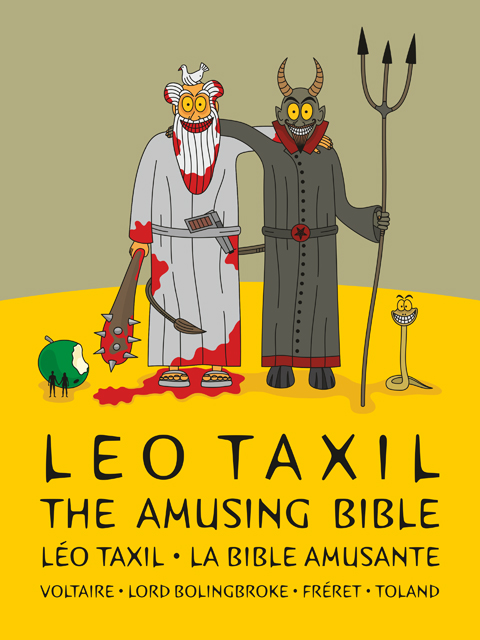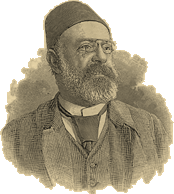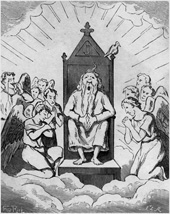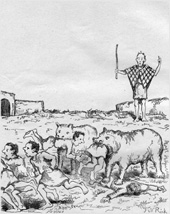Free downloads: “La Bible amusante” • “Забавная Библия” • “Biblijos linksmybės” • “Biblia hazlie”
|
SOURCE FILE / French text / English Bible quotes / Images
|
|
|
Image with God and Devil is created by us.
Images inside the book are scanned and fixed from 1892 French paper book version.
Text is scanned and fixed from 1904 French paper book version.
English Bible quotes are from various English Bible versions - which ones matched French version quotes.
If you know well both languages, French and English, you can download and use this source file to translate and help us to create English book version. You can re-use our work, as you like. If you will decide to make your work and English version free for everyone, we would be glad to put it on this website for free download. Recommended e-book software: Calibre. If you will need particular pages of original scans (total size is too big to put it here), please write us to info@infidels.eu
|
|
English version by Arthur Tovmasyan on Kindle (2015-09-02)
|
|

Leo Taxil and “The Amusing Bible”

Léo Taxil, originally Marie Joseph Gabriel Antoine Jogand-Pagès (1854-03-21 – 1907-03-31), was a French writer and journalist, who became known for his strong anti-Catholic and anti-clerical views. Leo Taxil was born in Marseille and at the age of five was placed into a Jesuit seminary. After spending his childhood years in the seminary he became disillusioned with the Catholic faith and began to see the religious ideology as socially harmful. He wrote in his confession: “Not without usefulness I spent my early years between monastery walls, among the clergy, where I grasped, on what rests the Papal faith.” Taxil was known for his writings like:
À bas la calotte! (Down calotte!) (1879)
Les Soutanes grotesques (The grotesque cassocks) (1879)
La Chasse aux corbeaux (Chase after crows) (1879)
Le Fils du jésuite (The Son of the Jesuit) (1879)
Les Bêtises sacrées (The sacred stupidity) (1880)
Les Friponneries religieuses (The religious knavery) (1880)
Plus de cafards! (More cockroaches!) (1880)
Calotte et calotins (Calotte and clericals) (1880-1882)
Les Borgia (The Borgias) (1881)
Les Pornographes sacrés (Sacred pornographers) (1882)
La Bible amusante (The amusing Bible) (1882) - first edition with ~400 pages
Un Pape femelle (The female Pope) (1882)
L'Empoisonneur Léon XIII (The Poisoner Leo XIII) (1883)
La Prostitution contemporaine (Contemporary prostitution) (1883)
Pie IX devant l'Histoire (Pius IX before History) (1883)
Les Amours secrètes de Pie IX (The Secret love-affairs of Pius IX) (1881)
Les Maîtresses du Pape (The Mistresses of the Pope) (1884)
La Vie de Veuillot immaculé (The Life of immaculate Veuillot) (1884)
In 1879 he was tried at the Seine Assizes for writing a pamphlet “À bas la calotte!” (Down calotte!) for insulting a religion, but he was acquitted. In his books, like “Les Pornographes sacrés” (Sacred pornographers) and “Les Maîtresses du Pape” (The Mistresses of the Pope), Taxil portrayed leaders of the Catholic Church as hedonistic creatures, exploring their fetishes in the manner of the Marquis de Sade.
In his anti-Catholic books “La Bible amusante” (The Amusing Bible) and “La Vie de Jesus” (The Amusing Gospel) Taxil satirically pointed out, what he considered to be inconsistencies, errors and false beliefs, presented in the Bible. First version of “The Amusing Bible” (~400 pages) was illustrated by 401 Frid'rick's illustrations and published in 1882 by “Libraire anticléricale”. At the time of publication the author was accused of irreverently mocking the Bible. “The Times” called for the book to be suppressed.
In 1884-04-20 Pope Leo XIII published an encyclical “Humanum Genus”, which said that the human race was “separated into two diverse and opposite parts, of which the one steadfastly contends for truth and virtue, the other of those things which are contrary to virtue and to truth. The one is the kingdom of God on earth, namely, the true Church of Jesus Christ... The other is the kingdom of Satan...” This kingdom was said to be “led on or assisted” by Freemasonry.
In 1885-04-23, after this encyclical, calling “to tear mask from freemasons”, Taxil repented, confessed and professed conversion to Catholicism. He renounced his earlier works and announced his intention to repair the damage he had done to the true faith. He was solemnly received back into the Church. One of the prominent figures of the Jesuit order, Gruber, wrote: “It has been only year, and as a result of papal prayers, grace of God’s ray touched one of the hard-core atheists and enemies of the Church, a publicist, who is capable more than others to implement call of Christ’s Vicar on earth.”
 Taxil wrote a series of pamphlets and books denouncing Freemasonry, charging their lodges with worshiping the devil, with blazing enthusiasm criticizing various godless infidels. The first book produced by Taxil after his conversion was a four-volume history of Freemasonry, which contained fictitious eyewitness verifications of their participation in Satanism. Taxil introduced fictitious Sophie Walder who had the talent of walking through walls and owned a snake who wrote prophecies on her back with the tip of its tail. Another book, called “The Devil in the Nineteenth Century”, introduced a new character - Diana Vaughan, a supposed descendant of the Rosicrucian alchemist Thomas Vaughan. The book contained many implausible tales about her ability to travel to various planets and encounters with incarnate demons, one of whom was played the piano in the shape of a crocodile. Diana was supposedly involved in Satanic “Palladism” cult, Satanic freemasonry, but was redeemed, when one day she professed admiration for Joan of Arc, at whose name the demons were put to flight. As Diana Vaughan, Taxil published a book called “Eucharistic Novena”, a collection of prayers which were praised by the Pope. These books had great sales among Catholics, although Diana Vaughan never appeared in public. In 1892 Taxil also began to publish a paper “La France chrétienne anti-maçonnique” (Anti-Masonic Christian France). In 1887 Taxil even had an audience with Pope Leo XIII, who subsequently sanctioned his anti-Masonic campaign and rebuked the bishop of Charleston for denouncing the anti-Masonic confessions as a fraud and in 1896 sent his blessing to an anti-Masonic Congress in Trent.
Taxil wrote a series of pamphlets and books denouncing Freemasonry, charging their lodges with worshiping the devil, with blazing enthusiasm criticizing various godless infidels. The first book produced by Taxil after his conversion was a four-volume history of Freemasonry, which contained fictitious eyewitness verifications of their participation in Satanism. Taxil introduced fictitious Sophie Walder who had the talent of walking through walls and owned a snake who wrote prophecies on her back with the tip of its tail. Another book, called “The Devil in the Nineteenth Century”, introduced a new character - Diana Vaughan, a supposed descendant of the Rosicrucian alchemist Thomas Vaughan. The book contained many implausible tales about her ability to travel to various planets and encounters with incarnate demons, one of whom was played the piano in the shape of a crocodile. Diana was supposedly involved in Satanic “Palladism” cult, Satanic freemasonry, but was redeemed, when one day she professed admiration for Joan of Arc, at whose name the demons were put to flight. As Diana Vaughan, Taxil published a book called “Eucharistic Novena”, a collection of prayers which were praised by the Pope. These books had great sales among Catholics, although Diana Vaughan never appeared in public. In 1892 Taxil also began to publish a paper “La France chrétienne anti-maçonnique” (Anti-Masonic Christian France). In 1887 Taxil even had an audience with Pope Leo XIII, who subsequently sanctioned his anti-Masonic campaign and rebuked the bishop of Charleston for denouncing the anti-Masonic confessions as a fraud and in 1896 sent his blessing to an anti-Masonic Congress in Trent.
 Doubts about Vaughan's veracity and even her existence began to grow, and finally Taxil promised to produce her at a lecture to be delivered by him on 1897-04-19 at the Hall of the Geographic Society in Paris. To the amazement of the audience (which included a number of priests) he announced that Diana Vaughan was one of a series of hoaxes as a part of long-lasting practical joke to ridicule the Roman Catholic Church’s credulity. He thanked the bishops and Catholic newspapers for facilitating his crowning hoax, namely his conversion, which had exposed the anti-Masonic fanaticism of many Catholics. Diana Vaughan was revealed to be a simple typist and his employ, who laughingly allowed her name to be used by him. Taxil widely and vividly described, how all these twelve years he deliberately and consistently mystified religious servants, how, step by step, he more and more puffed up and diversified his fabrications, seeing, that even the most incredible fantasies were fascinatedly taken on face value by the pope, cardinals, and all the Catholic clergy. It was a terrible scandal. Discredit of the clergy was enormous.
Doubts about Vaughan's veracity and even her existence began to grow, and finally Taxil promised to produce her at a lecture to be delivered by him on 1897-04-19 at the Hall of the Geographic Society in Paris. To the amazement of the audience (which included a number of priests) he announced that Diana Vaughan was one of a series of hoaxes as a part of long-lasting practical joke to ridicule the Roman Catholic Church’s credulity. He thanked the bishops and Catholic newspapers for facilitating his crowning hoax, namely his conversion, which had exposed the anti-Masonic fanaticism of many Catholics. Diana Vaughan was revealed to be a simple typist and his employ, who laughingly allowed her name to be used by him. Taxil widely and vividly described, how all these twelve years he deliberately and consistently mystified religious servants, how, step by step, he more and more puffed up and diversified his fabrications, seeing, that even the most incredible fantasies were fascinatedly taken on face value by the pope, cardinals, and all the Catholic clergy. It was a terrible scandal. Discredit of the clergy was enormous.
The audience received these revelations with laughter, some with indignation and hiss. Taxil was mobbed on leaving the hall so that policemen had to escort him to a neighbouring café.
Clerics were enraged. Leo XIII gave anathema to Taxil. “We...” - it was said in the papal bull - “...declare, that excommunicate and anathematize that villain, who is called the Leo Taxil, and expel him from the door of the holy Church of God... May he be damned wherever he is: in the house, in the field, on the road, on the stairs, in the desert and even on the threshold of the church. May he be cursed in life and in the hour of death. May he be cursed in all his affairs when he drinks, when he eats, when he is hungry and thirsty... May he be cursed in all parts of the body, internal and external... May he be cursed in all his the joints, for the disease gnawed him from the top of the head to the soles of feet... ”
This didn't frighten Taxil and extended version (~800 pages, 401 illustrations by Frid'rick) of the book “La Bible amusante” (The Amusing Bible) was republished from year 1897. Extended version contained Taxil's public letter, addressed to Pope Leo XIII at the beginning of the book, quotes from the Bible and comments by Voltaire, Lord Bolingbroke, Fréret, Toland and others.
Leo Taxil moved away from Paris and died in Sceaux in 1907.




